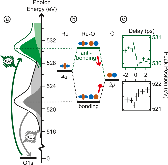Chemical bond activation observed with an x-ray laser
Journal Article
·
· Journal of Physical Chemistry Letters
more »
- Helmholtz-Zentrum Berlin fur Materialien und Energie GmbH, Berlin (Germany); SLAC National Accelerator Lab., Menlo Park, CA (United States); Deutsches Elektronen-Synchrotron (DESY) Photon Science, Hamburg (Germany)
- Stockholm Univ., Stockholm, (Sweden)
- SLAC National Accelerator Lab., Menlo Park, CA (United States)
- Univ. Hamburg and Center for Free-Electron Laser Science, Hamburg (Germany)
- Helmholtz-Zentrum Berlin fur Materialien und Energie GmbH, Berlin (Germany); Univ. Potsdam, Potsdam (Germany)
- Helmholtz-Zentrum Berlin fur Materialien und Energie GmbH, Berlin (Germany)
- SLAC National Accelerator Lab., Menlo Park, CA (United States); Chapman Univ., Orange, CA (United States)
- SLAC National Accelerator Lab., Menlo Park, CA (United States); Stockholm Univ., Stockholm, (Sweden)
- The Univ. of Liverpool, Liverpool (United Kingdom)
- SLAC National Accelerator Lab., Menlo Park, CA (United States); Stockholm Univ., Stockholm, (Sweden); KTH Royal Institute of Technology, Stockholm (Sweden)
- Fritz-Haber Institut der Max-Planck-Gesellschaft, Berlin (Germany)
- Deutsches Elektronen-Synchrotron (DESY) Photon Science, Hamburg (Germany); Univ. Hamburg and Center for Free-Electron Laser Science, Hamburg (Germany)
The concept of bonding and anti-bonding orbitals is fundamental in chemistry. The population of those orbitals and the energetic difference between the two reflect the strength of the bonding interaction. Weakening the bond is expected to reduce this energetic splitting, but the transient character of bond-activation has so far prohibited direct experimental access. Lastly, we apply time-resolved soft X-ray spectroscopy at a free-electron laser to directly observe the decreased bonding–anti-bonding splitting following bond-activation using an ultra short optical laser pulse.
- Research Organization:
- SLAC National Accelerator Laboratory (SLAC), Menlo Park, CA (United States)
- Sponsoring Organization:
- USDOE Office of Science (SC), Basic Energy Sciences (BES)
- Grant/Contract Number:
- AC02-76SF00515
- OSTI ID:
- 1349302
- Journal Information:
- Journal of Physical Chemistry Letters, Vol. 7, Issue 18; ISSN 1948-7185
- Publisher:
- American Chemical SocietyCopyright Statement
- Country of Publication:
- United States
- Language:
- English
Cited by: 22 works
Citation information provided by
Web of Science
Web of Science
Similar Records
Ultrafast X-ray Transient Absorption Spectroscopy of Gas-Phase Photochemical Reactions: A New Universal Probe of Photoinduced Molecular Dynamics
Chemical activation of molecules by metals: Experimental studies of electron distributions and bonding: Progress report for period March 1, 1986--September 30, 1988
Probing reaction dynamics of transition-metal complexes in solution via time-resolved soft x-ray spectroscopy
Journal Article
·
Wed Nov 21 00:00:00 EST 2018
· Accounts of Chemical Research
·
OSTI ID:1349302
Chemical activation of molecules by metals: Experimental studies of electron distributions and bonding: Progress report for period March 1, 1986--September 30, 1988
Technical Report
·
Fri Jan 01 00:00:00 EST 1988
·
OSTI ID:1349302
Probing reaction dynamics of transition-metal complexes in solution via time-resolved soft x-ray spectroscopy
Conference
·
Fri Aug 01 00:00:00 EDT 2008
·
OSTI ID:1349302
+3 more



